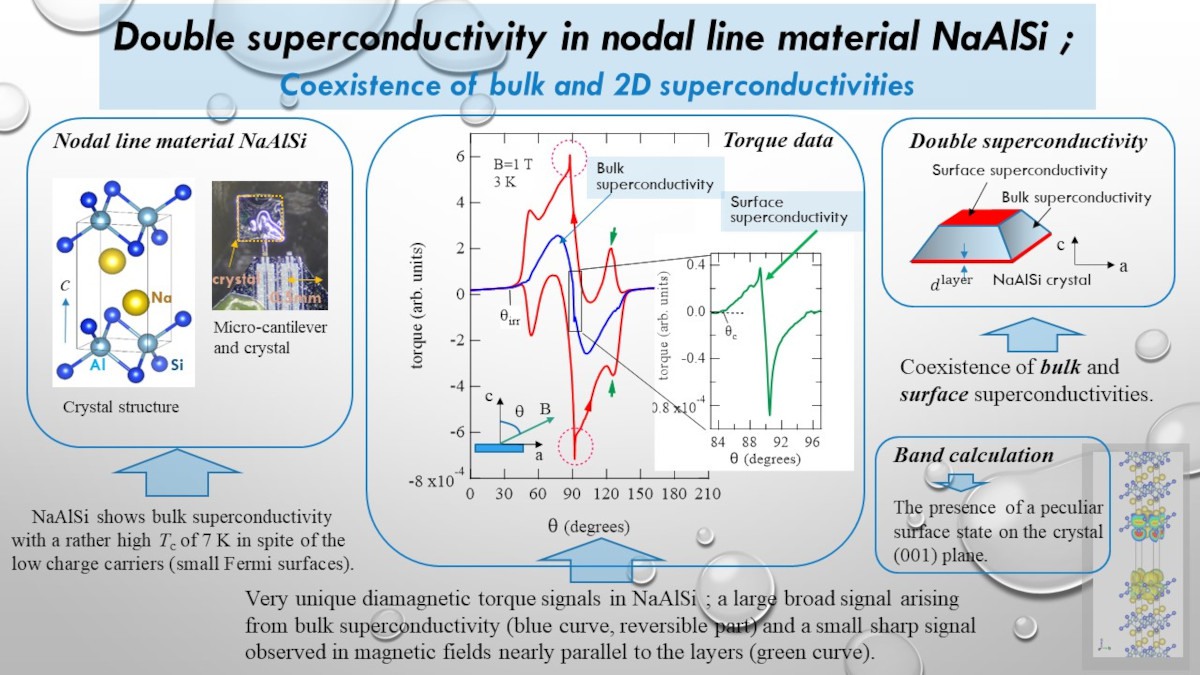Double Superconductivity in Nodal Line Material NaAlSi; Coexistence of Bulk and 2D Superconductivities
© The Physical Society of Japan
This article is on
Anomalous Diamagnetic Torque Signals in Topological Nodal-Line Semimetal NaAlSi
(JPSJ Editors' Choice)
J. Phys. Soc. Jpn. 92, 074703 (2023).
Unique diamagnetic torque signals are found in the nodal line material NaAlSi, which suggests the presence of double superconductivity; i.e., bulk superconductivity and 2D superconductivity on the crystal surface.

Topological materials have attracted great interest because of unique electronic states resulting from their linear energy dispersion. A large number of topological materials have been synthesized and discovered. Among them, some topological materials have unique band structures. The crossing points of the bands with linear dispersion, called Dirac points, extend in k-space and form nodal line loops. One of the most intriguing properties of such topological nodal line materials is the formation of surface states on certain crystal surfaces. Till now, extensive efforts have been made to elucidate the surface states of topological materials.
The nodal line material NaAlSi has a tetragonal unit cell composed of Al-Si tetrahedral layers and Na in between. Conduction bands are formed by the s and p orbitals of Al and Si. In spite of the low charge carriers (small Fermi surfaces), NaAlSi shows bulk superconductivity with a rather high Tc of 7 K.
Magnetic torque is defined as the outer product of the magnetic field and magnetization. We have performed magnetic torque experiments on single crystals of NaAlSi using a micro-cantilever, which is a powerful technique for detecting anisotropic magnetic properties. Owing to its layered structure, NaAlSi has anisotropic critical magnetic fields. Thus, it is possible to precisely measure the diamagnetic signal arising from the superconductivity even for a tiny single crystal.
In torque measurements below Tc, very unique diamagnetic torque signals have been observed in NaAlSi, i.e., a large broad signal arising from the bulk superconductivity and a small sharp signal observed in magnetic fields nearly parallel to the layers. Owing to the high anisotropy of the critical field, the sharp signal is ascribed to the 2D superconductivity in the Na-Si layers (perpendicular to the c-axis). The thickness of the 2D superconductivity is only several times the crystal c-axis (0.736 nm). As band calculation predicts the presence of a peculiar surface state on the crystal (001) plane, a possible explanation for the torque data is the coexistence of the bulk superconductivity and surface conductivity on the (001) plane. Further studies are necessary to understand the relationship between both superconductivities and the mechanism of 2D superconductivity.
(Written by S. Uji on behalf of all authors)
Anomalous Diamagnetic Torque Signals in Topological Nodal-Line Semimetal NaAlSi
(JPSJ Editors' Choice)
J. Phys. Soc. Jpn. 92, 074703 (2023).
Share this topic
Fields
Related Articles
-
Antiferromagnetism Induces Dissipationless Transverse Conductivity
Electronic transport in condensed matter
Magnetic properties in condensed matter
Electronic structure and electrical properties of surfaces and nanostructures
2024-7-24
An investigation using high-quality NbMnP crystals demonstrates that the anomalous Hall conductivity arising from antiferromagnetism is dissipationless, as expected from the intrinsic mechanism.
-
Microscopic Exploration of Electronic States in Nickelate Superconductors
Magnetic properties in condensed matter
Superconductivity
2024-5-31
The multilayered nickelates, La3Ni2O7 and La4Ni3O10 , were investigated using nuclear magnetic resonance (NMR) at ambient pressure. Metallic electronic states under the density wave order were observed microscopically for both compounds.
-
Single-Crystal Growth of a Cuprate Superconductor with the Highest Critical Temperature
Superconductivity
2024-5-20
Millimeter-sized single crystals of a trilayer cuprate superconductor (Hg,Re)Ba2Ca2Cu3O8+δ that exhibits the highest superconducting transition temperature under ambient pressure, were grown reproducibly and safely.
-
Cooking in Salt for Ultra-Clean Superconductor UTe2
Superconductivity
2024-4-30
A new crystal growth technique, the molten salt flux liquid transport method, was developed to produce high-quality single crystals of spin-triplet superconductor UTe2. This method is promising for exploring the exotic superconductivity of other materials.
-
Exploring Electronic States in BEDT-TTF Organic Superconductors
Superconductivity
Electronic transport in condensed matter
Magnetic properties in condensed matter
2024-4-24
This review, published in the Journal of the Physical Society of Japan, provides a comprehensive summary of the electronic states observed in BEDT-TTF type organic superconductors, including metal-insulator transitions, Mottness transitions, non-Fermi liquids, quantum spin liquids, and Bose-Einstein condensation.
